Neil Peart's News, Weather and Sports
Telescope Peak Revisited
NeilPeart.net, April 28, 2014
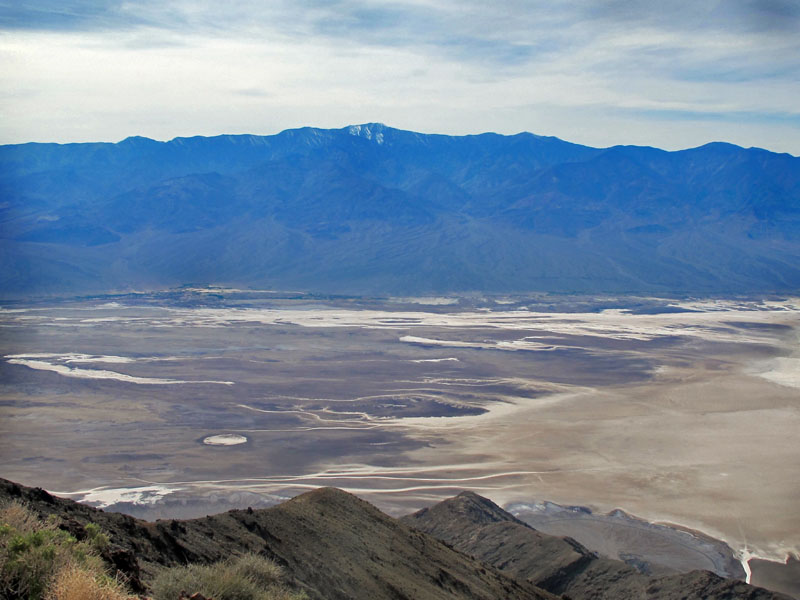 |
Dante's View |
After riding up the steep switchbacks to the mile-high lookout of Dante's View, in Death Valley National Park, I straddled my motorcycle at the edge, looking west, and thumbed the kill switch. All was suddenly quiet and still, and I sat for a few minutes, facing that majestic vista, seeing it - and feeling it - as I had so many times before. For seven hours and almost 500 miles I had been wandering the backroads of California's Mojave Desert, so I was a little sore and tired, and ready to "get there." But I would not have missed that unparalleled viewpoint - hadn't even considered passing by the winding little road up to Dante's View.
Eighteen years and dozens of visits had not dulled its radiance. If anything, knowing the place so well made it more alive, with memories of viewpoints, hiking trails, mountaintops, and perhaps most vital of all, so many stories, personal and historic. Since my first sight of Death Valley, under a full moon in late 1996, to two days of filming scenes for my instructional DVD, Taking Center Stage, in various locations around the park in early 2011, my senses had been thrilled and my imagination inspired by one of my favorite landscapes.
Though it's not really a landscape so much as a dreamscape. (I like the word the late great art critic Robert Hughes used to describe the paintings of Giorgio de Chirico: "oneiric" - dreamlike. And de Chirico, an early surrealist who founded the scuola metafisica, might be one artist who could have rendered Death Valley in paint.)
Death Valley is powerfully surreal and overwhelmingly strange, otherworldly. In some previous stories about spectacular views in the American West, I have resorted to musical metaphors - describing the sensory experience of standing before Grand Canyon as like a power chord, and the monumental rock formations of Zion Canyon as "frozen music," specifically an orchestral G major. Seen from this elevation, Death Valley struck a mighty chord as well, but the harmonic convergence included a slight dissonance, a disturbing harmony, an eeriness.
From lower down, like sitting on the terrace of the Furnace Creek Inn at sea level, looking across the shimmering valley floor to the dark, chiseled Panamint Range, the music changes to a steady, thick drone of gradually shifting harmonies. I think of 2001: A Space Odyssey - that choral piece "Lux Aeterna" (eternal light, fittingly) by György Ligeti, like voices from Purgatory (likewise suitably "Dantean").
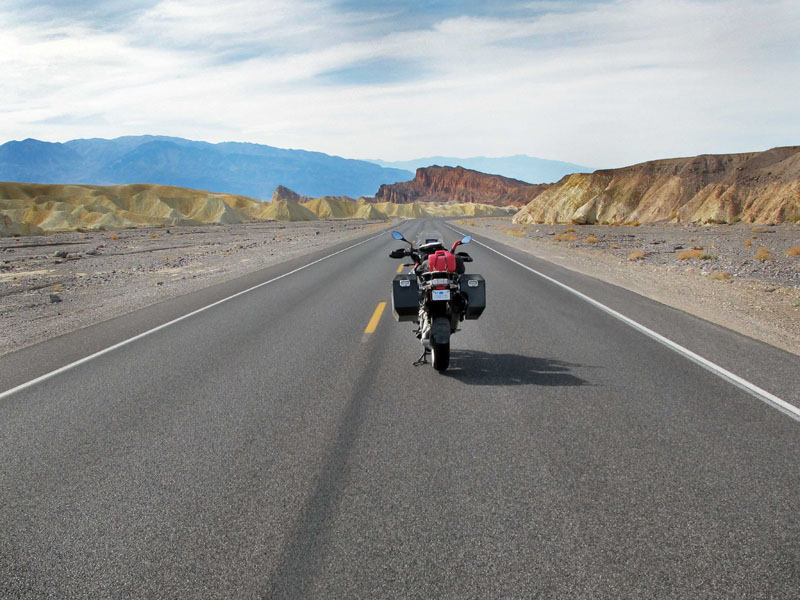 |
Zabriskie Point |
The vast, sunken basin is the hottest, driest place in North America, and typically thrums with almost visible heat. Even on that early April day, it was 103 degrees at Furnace Creek. The stark bareness of it all - the white swirls of the "chemical desert," the brown folds of bare rock in the Panamints behind - were the very definition of naked geology.
Looking out from Dante's View, at 5,475 feet, is overwhelming to the senses, and the topography is endlessly fascinating - even just considering the numbers. From my mile-high vantage, I looked down at Badwater Basin, almost 300 feet below sea level, and across the valley floor to the chocolate-brown alluvial fans of eroded debris (called bajadas when they join), and the wrinkled brown shoulders of the Panamints. The view centered on Telescope Peak, the highest summit in Death Valley National Park, at 11,049 feet.
The snowy streaks visible in the opening photograph mark the area surrounding Telescope Peak, and seeing that made my heart sink a little. My plan for the following day was to hike up Telescope Peak and view that scene in reverse - from there to here. Now that might not be possible. (At such a moment, you wish you could hold a defiant fist up to a sky-god and shout, "Hey man - I trained for this!")
I had last stood on that summit almost fifteen years before, in October, 1999. All unexpectedly, that place and time had marked a major turning point in my life - a hinge of fate, as it were. In writing my story of that time, in Ghost Rider, I came to realize that the hike up Telescope Peak was an important "plot point." Dramatic. Symbolic.
Five-and-a-half years later, in April 2005, I planned a second attempt on Telescope Peak, but was warned by the park rangers that the higher elevations had too much snow and ice to climb without winter mountaineering gear - crampons and ice axes and such. I didn't have any of those on my motorcycle. (Note to self: a man of your age and station ought to possess an ice axe.) So that day I hiked up nearby Wildrose Peak instead, at only 9,064 feet, and still had to work around or through a fair amount of snow.
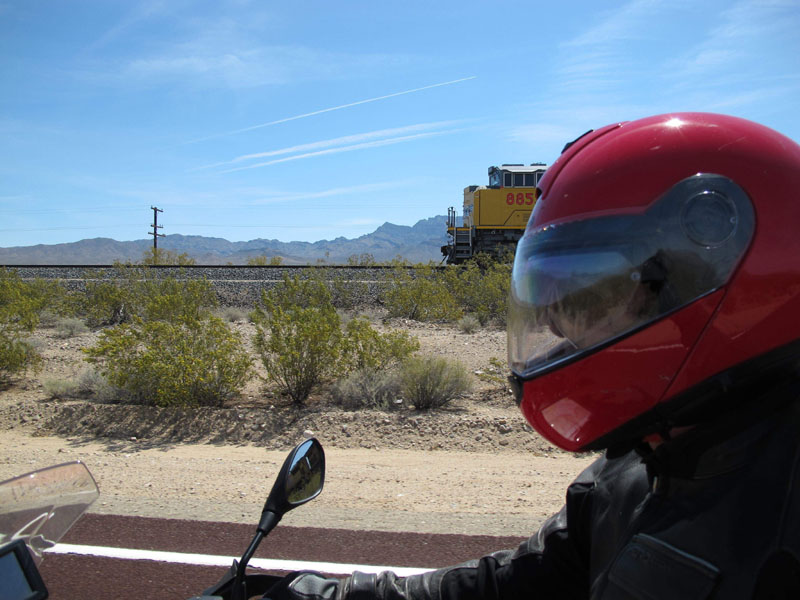 |
Desert Race - Two Wheels Will Win (As soon as I put away this camera) |
This time, looking out from Dante's View in April, 2014, I saw that snow, and knew that, like my motorcycle route that day, the next day's hiking plans would have to be...improvised...
Before setting out from home at dark o'clock that morning, I had not let myself decide anything about the route I would take, even the general direction. My only plan was to arrive at Stovepipe Wells in Death Valley by late afternoon - cocktail time - and there were many pleasant ways to accomplish that modest goal. After eighteen years of rambling around the Mojave, I knew its roads, major and minor, pretty thoroughly. Having lived in Southern California for over fourteen years, the desert was part of my "neighborhood," like the majestic Sierras around Kings Canyon and Sequoia National Parks, or the Pacific Coast Highway up through Big Sur and the redwoods. So I could improvise a route at will - the most "liberated" of journeys.
In a choice between exploring a new route with map and GPS, or simply wandering among familiar favorite roads and turning at "whim-points," the odds seem to favor the latter - much higher chances of having a great ride. Because experience.
Before publishing Roadshow in 2005, I had collected notes in 1996 and '97 for a similar book I was going to call American Echoes: Landscape With Drums. Its writing was interrupted when some jealous deity or other worked in mysterious ways and took my family "to a better place" - but I found this passage from that draft, describing my first "enlightenment" about the Western deserts.
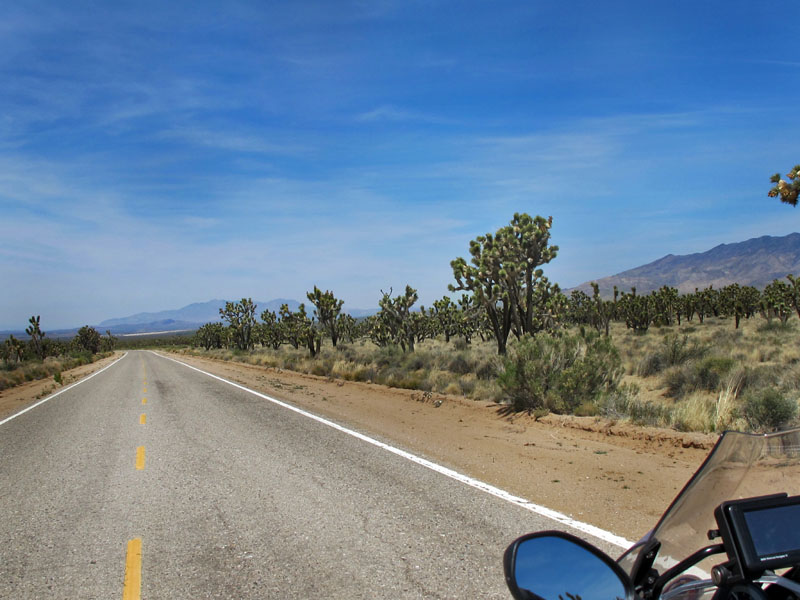 |
Joshua trees |
Until this time, I had never considered myself to be much of a "desert person." As a nature-lover, I appreciate all kinds of landscapes, from seashore to farmland to prairie, but as already stated, my favorite is always forested mountains. Not necessarily big, majestic mountains like the Alps or the Rockies, but nice rolling land with trees and rivers or lakes, like the Black Forest, or my beloved Laurentians. It's the dynamic topography, the foliage, the smells, the sheltered little roads, and the trees reflected in water.
However, the desert was starting to grow in my "soulscape." The colors of tan and gray under wide blue skies, the hardy shrubs and cacti, but more than anything, it was a response to all that space. Brutus had spent a few years living near El Paso, and he told me that when he first went there he wasn't too impressed by the landscape. It seemed bleak and empty; there was nothing there. Later he'd come to realize that this was the point - there was so much nothing there - and now this understanding was starting to creep into me.
For humans, perhaps the greatest luxury in the world is simply space, in all its forms. This is increasingly true on our ever-more-crowded planet (and the idea first occurred to me in China, and then again while sharing an eighteen-seat African bus with forty people), but it has been true since ancient times. Big buildings and big rooms have always been symbols of importance and prestige, and whether these extremes of "personal space" were built to house a king, a god, or a tycoon, their size is not necessarily a reflection of ego, but rather to provide and display the luxury of space. Even simple manifestations of this impression, like a magazine layout with generous blankness around its text and illustrations, play to the same sensibility in the viewer. Unlike other elements, the space is not there to do a job; it's not "working," it's just plain, luxurious space.
When the horizon is low and flat on every side, like in the middle of an ocean or a desert, the sky cannot get any bigger. Mountains that seem clear and close are actually a hundred miles away, the full length of a train is stretched along the horizon in tiny blocks of color, and at night, the lights of an approaching town take forever to reach.
So the desert has space, it has nice air, it has good roads with stunning vistas of mountains and rugged cliffs, and it has little traffic. On this, our second crossing of the Mojave, I was feeling the desert in a way I never had before. Certainly the motorcycle had something to do with that.
That morning, as I wheeled the bike out of the garage into the dark streets of Westside Los Angeles, it seemed suddenly clear that I should ride east on Interstate 10. Once through the megacity and past Palm Springs, into the open desert, I should turn off at Joshua Tree National Park. Heading north from there, I would have a choice of several two-lane routes through the Mojave, the high desert, in the general direction of Death Valley.
In early April, the weather was likely to be relatively cool, and I was looking forward to seeing the wildflowers in bloom. It wasn't something you could ever count on - not a regular occurrence in that harsh environment, and even then short-lived - but it was something you could hope for. (A metaphor in there somewhere.)
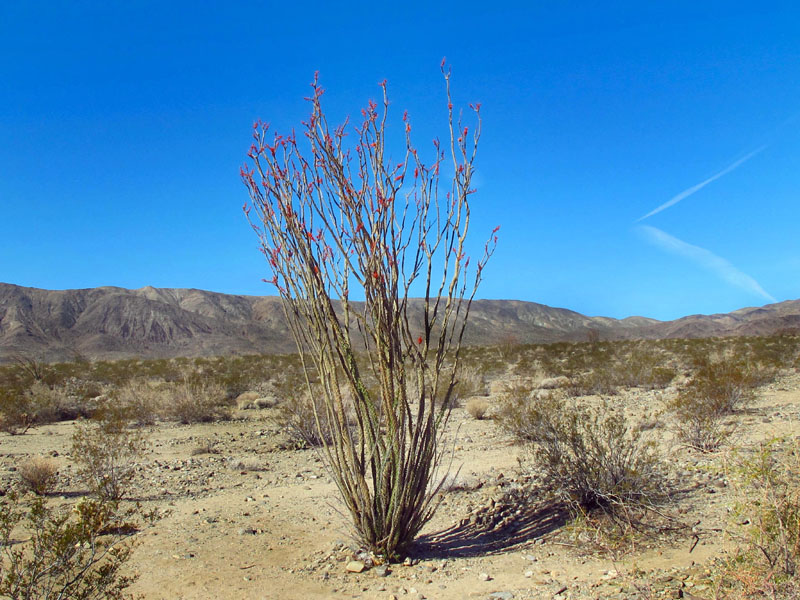
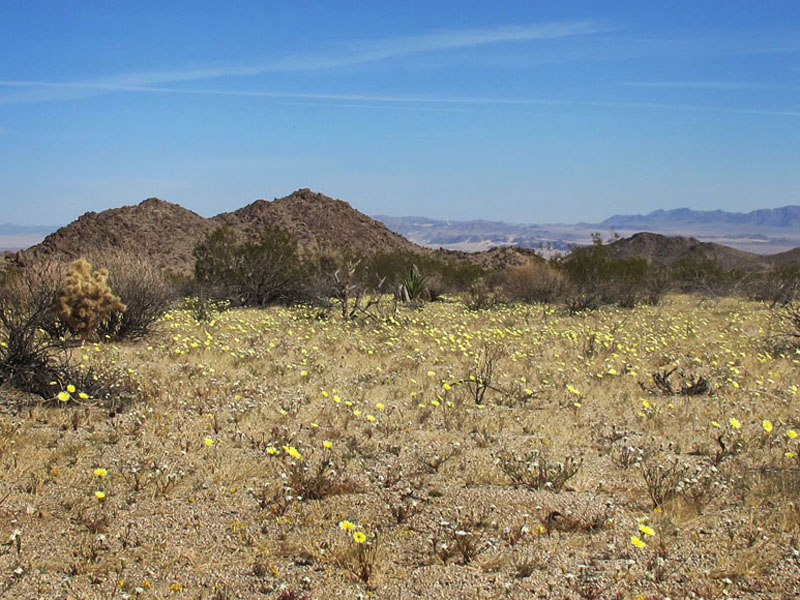
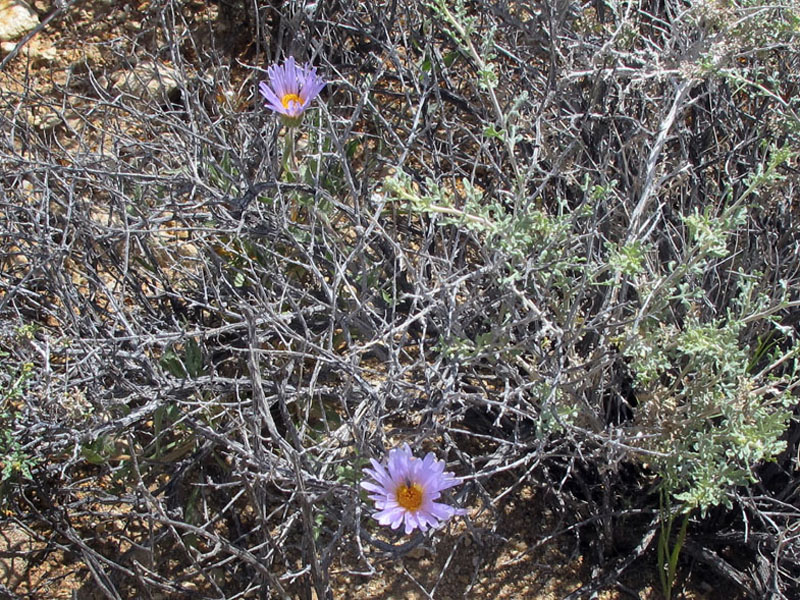
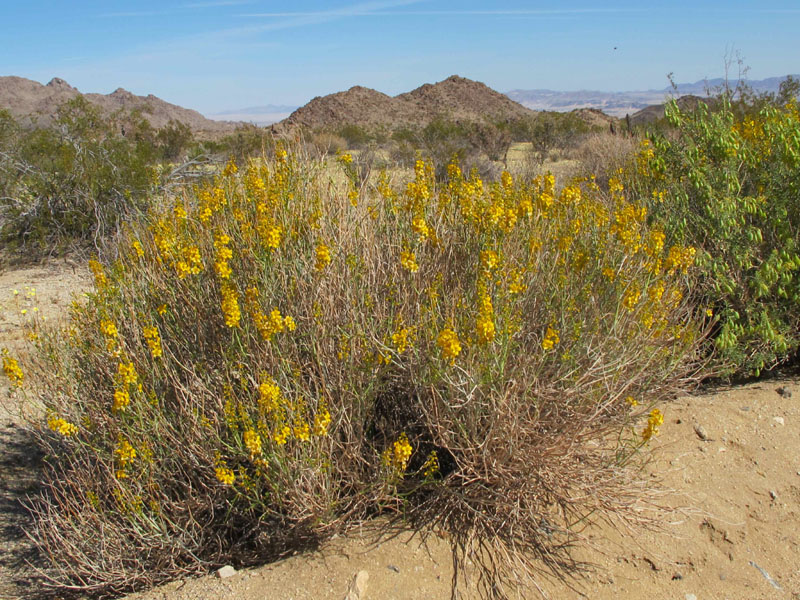
Years ago I had been surprised to learn that the busiest season for visitors in Death Valley is March and April. Because flowers. Perhaps the attraction can be compared to the autumn "leaf-peepers" who crowd the Northeast - New England, Ontario, Quebec - every October, in cars, minivans, SUVs, and bus tours. Both seasons offer a short, spectacular display, but the wildflower bloom in the Mojave is more subtle - and elusive. In fact, it only really shows off maybe once every twenty years, when the rain is timed and measured exactly right.
The rains had certainly been good for this sacred datura - the largest, liveliest plant of its kind I have ever seen in the Mojave. It glorified the roadside just outside Joshua Tree National Park, with Twentynine Palms in the background, and I saw several like it that day.
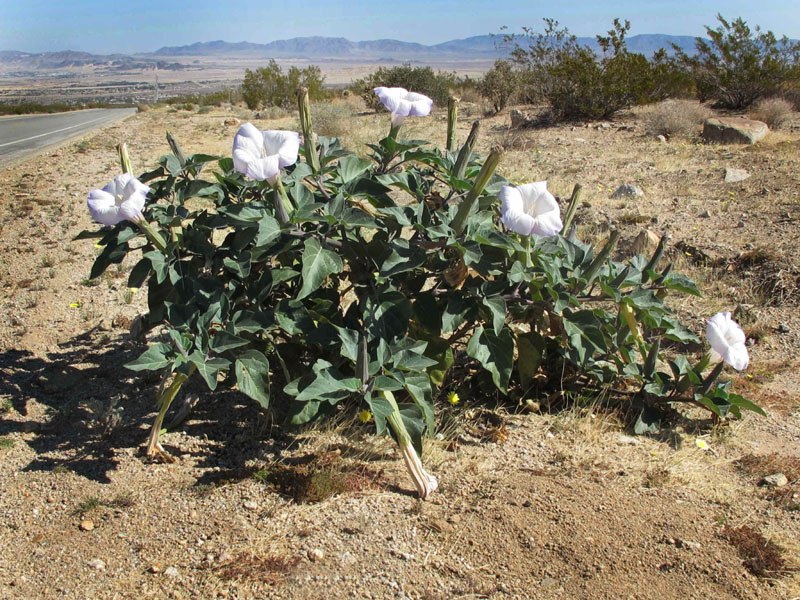 |
Sacred Datura |
In other years, I had sometimes noticed a white, trumpet-shaped flower or two, laying pale and limp beside its dark stems and leaves in the roadside gravel. But this was a spirited-looking bloom indeed, the white petals standing proud, and delicately tinted around the outside with lavender. (Note the tiny yellow desert dandelions thriving in its shade.)
Many years ago a cab driver in Tucson told me sacred datura was a hallucinogen, and something about his manner said he spoke from experience. However, the entire plant is highly poisonous, and one description of a Zuni rite of manhood which included ingesting a drink made from sacred datura ends chillingly: "Not all of the boys survived."
The plant is holy to some Native Americans (hence the name), and its observed effects gave rise to the disrespectful name "Indian whisky." Also called jimsonweed, angel trumpet, moon lily, and in Spanish, yerba del Diablo - devil's weed - it is used for the traditional "vision quest" ritual, when hallucinations are said to reveal the animal whose spirit dwells within you.
In the late '60s and early '70s, a popular series of "spiritual" books was written by Carlos Castañeda. (Now there's a story - not just the books, but the author. After selling twenty-eight million books in seventeen languages, Castañeda retired from public life in 1973. He bought a mansion in Los Angeles, and started his own cult - "Fellow Travelers of Awareness" - with three female friends, who gave up their identities, families, and friends. Even his death, in 1998, was secret, and went unreported for two months. Later, the remains of one of the women was found near Death Valley.) Leading off with The Teachings of Don Juan: A Yaqui Way of Knowledge, in 1968, Castañeda's books were notorious among the '60s hippies for his experiments with psychedelics, especially peyote - but it was apparently datura tea he consumed on the vision quest when he reported turning into a crow and actually flying.
Coincidentally, in another vision quest, just the previous week friend Craiggie had fooled around with a photo from a hike I did in Topanga State Park with Greg Russell, and created this remarkable "hallucination." I liked that it seemed to reveal my spirit as a ferruginous hawk - not some showy, vainglorious eagle, you understand, but just one step below, the largest of hawks. That would be cool.
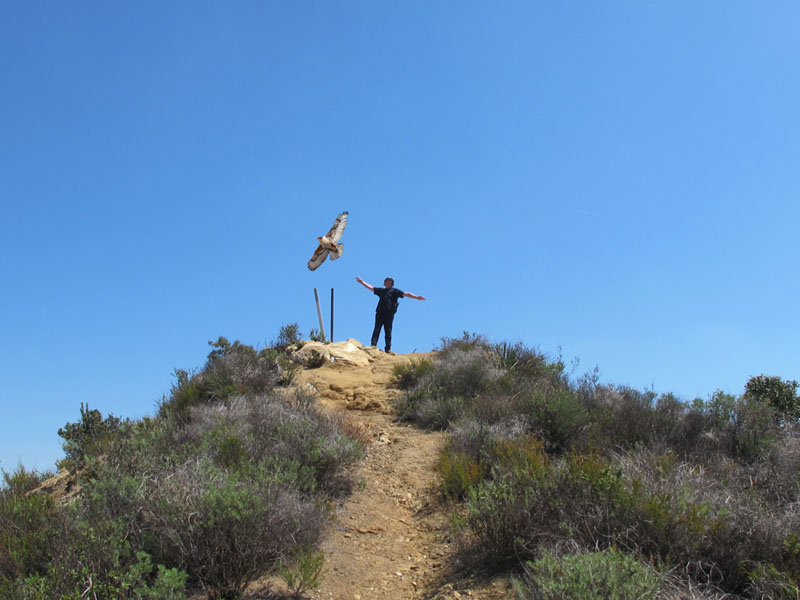
However, I think I'll take a pass on the datura tea, thanks anyway. Because poison.
In my years of desert travels on various vision quests, I have observed that in such a demanding, unforgiving environment, roads are demonstrably a good thing - not just for motorcycling and driving, but for the natural flora. Any rain that falls on the strips of pavement runs off to the side, bringing just enough extra moisture that the roadside shrubs are markedly larger than those in open country. In spring, the wildflowers thrive along the pavement's edge.
Mile after mile, with rarely another vehicle in sight, I rode through the Mojave's vast, oceanic sweep, distant brown peaks framing wide, gently undulating seas of patterned creosote. The creosote bushes grow in colonies, each a careful distance apart (either poisoning the soil around them with chemicals in their roots, or simply absorbing every drop of moisture - scientists are not sure), and collectively they are the oldest living organisms on Earth - some colonies over 10,000 years. A few of the creosote branches displayed their tiny yellow flowers, and I rode between tall, spindly ocotillos studded with blossoms like red jewels, and the fetching gesticulations of the Joshua trees. All the while, my eyes glanced down at the the evanescent wildflowers to either side - shy flecks of yellow, white, red, orange, and purple. Brittlebush, asters, desert paintbrush, datura, lupines, and a few others were familiar. Many others I couldn't identify, but they delighted me just the same.
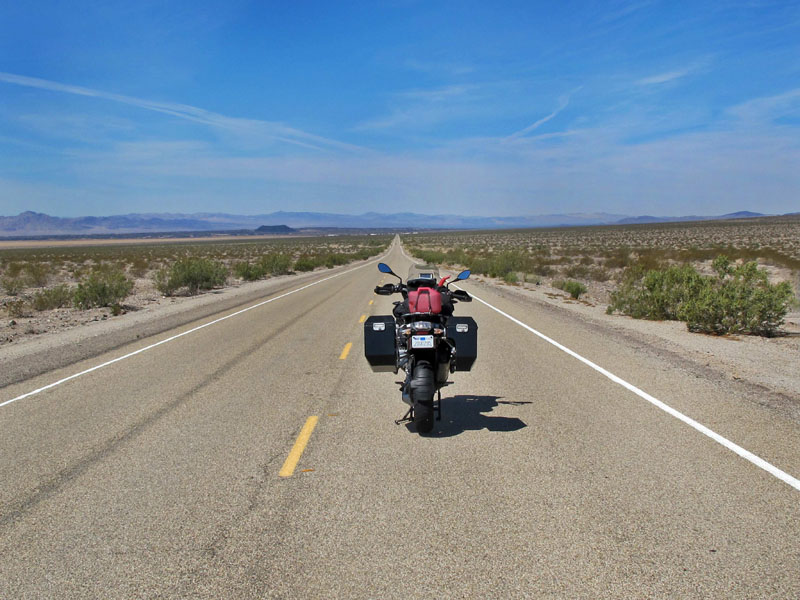 |
Route 66 |
Riding out of Joshua Tree, I paused in Twentynine Palms for gas, then continued up the Amboy Road to Old 66. The above "Ghost Rider" shot - one of many in a sixteeen-year series - was taken there, looking west toward Amboy, Roy's Motel in the distance, and the Amboy Crater to the left. Pretty well every time I pass that way, by motorcycle or car, I pause to set up a shot like this. I hope I always will.
Because memory.
Ahead of me, I still had some attractive route options to consider, and was reminded of another advantage to carrying my spare gas can, apart from emergencies: my choice of roads was less restricted by the location of gas stations. I turned north on Kelbaker Road, with a choice to make at Kelso Depot - at that fork I could stay left on the straight-through route up to Baker and Death Valley, or turn right onto the shunpikers' choice, into the wilder parts of the Mojave National Preserve.
I shunpiked.
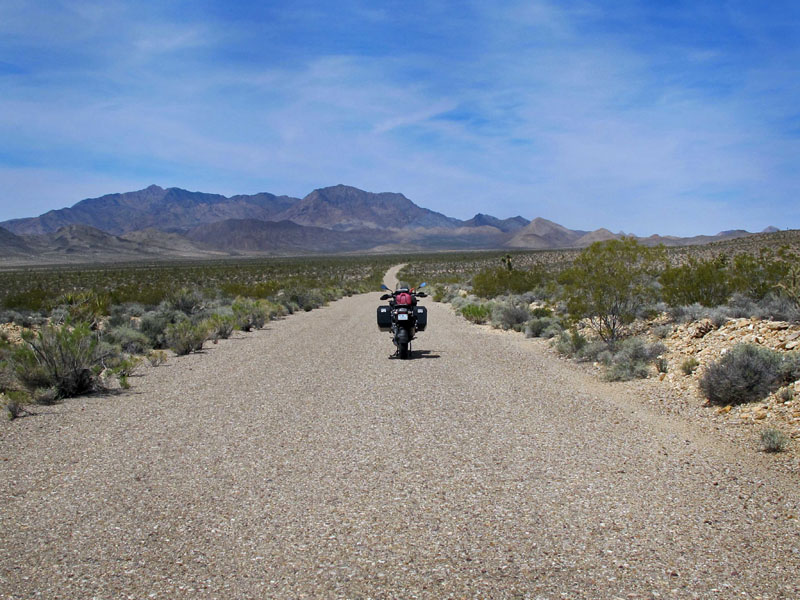 |
Excelsior Mine Road |
At the next fork, at Cima, I turned north to the intersection with Interstate 15, where I fueled up again. The temperature had climbed into the 80s, heading for the 90s, so I stripped off a few layers of gear, then crossed the freeway and rode back into open desert. A neglected, overgrown track of rough pavement called the Excelsior Mine Road curved west, traversing the remote, mostly abandoned mines of the Kingston Range. It climbed to a narrow, rocky little pass called after the next town, Tecopa, and I knew things could get difficult there. It was my third time passing that way, and the first time the unpaved pass had been rough; the next time it was even worse, and I was worried that by now it might have deteriorated to impassibility. One flash flood could do it. However, the Tecopa Pass had obviously been graded recently, which meant there was some kind of economic activity continuing around there - because it still followed my basic definition of a road's purpose: "Money at one end, a bank at the other."
In the desert hamlet of Shoshone (population thirty-one in 2010, down from fifty-two in 2000), just outside Death Valley National Park, I decided to pause at the bar and grill called the Crowbar (heh-heh). Over the years I have often enjoyed their fine cheeseburgers and lemonade (I like how they serve it in Mason jars). As I stood outside by the bike, getting myself organized to head inside, I looked over at the gas station across the road. A gathering of numerous green dual-sport motorcycles clustered around the pumps, and I knew who they must be. Motojournalist friend Brian Catterson had told me he would be around Death Valley that week, attending a press introduction of the latest Kawasaki KLR-650 (long the benchmark for single-cylinder dual-sport bikes - meaning on- and off-pavement - since their introduction in 1987, so not exactly a "new model intro").
Even from across the road I recognized Brian's pyramid of thick hair above his gray Aerostich suit, and a moment later he looked over, saw me, and ambled across. When he got close, he grinned and said, "I recognize that gas can!" (He always likes to kid me for carrying that, as I always do between the Mississippi and the Coastal Ranges.) We shared a hug that was necessarily big and manly, both still encased in armored riding suits.
I knew the Kawasaki group was staying at the Furnace Creek Inn - part of the reason I had found that longtime favorite destination to be short of good rooms. In any case, I had already decided to stay at the budget-priced Stovepipe Wells property - still perfectly acceptable to this desert rat, and twenty-five miles closer to my hoped-for trailhead the following morning.
Stovepipe Wells is more-or-less in the middle of Death Valley, near the Mesquite Flat Sand Dunes (said to be the most photographed dunes in the world). A rambling compound of single-storey motel units (with park-in-front-of-your-door convenience), it offers a decent restaurant, a "saloon," and a general store (mostly souvenirs) with gas pumps (Regular only). It did not boast the beauty or luxury of Furnace Creek Inn - or the spectacular "Lux Aeterna" view over the valley floor and across to the Panamints - but I had enjoyed those features numerous times before. This trip, Stovepipe Wells would be perfectly comfortable.
Brian suggested we get together later, but I said no, I'd just stay where I was - "With the poor people," I laughed. I should have explained that the reason I didn't want us to get together was that we were staying twenty-five miles apart, on motorcycles, so it wouldn't be a good idea.
Because alcohol.
Of course I am a drinking man, but strict about it with regard to motorcycling. "No drinking and riding. Not even one."
I made a mental note to explain that to Brian later, so he wouldn't take it personally.
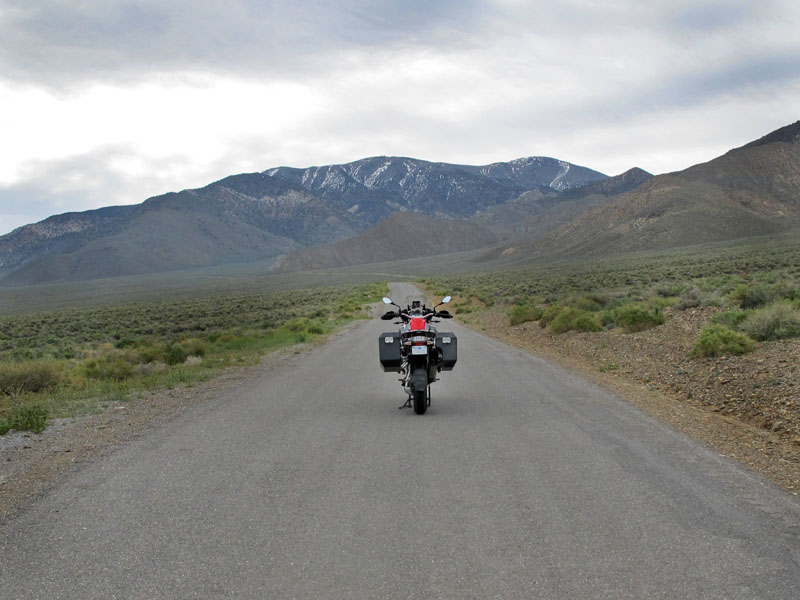 |
Emigrant Canyon |
Early next morning I was riding up through Emigrant Canyon, into the higher-elevation meadows of sage and grasses. Wildflowers were especially plentiful there, in patches of yellow, white, blue, and dark red. I was aiming for the higher trailheads to Wildrose and Telescope Peaks. I figured I would just see how things were up there, then decide what would be possible. (Might be another metaphor in there.)
I am not one to believe in omens, but I do like symbols, and the idea of hiking up that trail to Telescope Peak again, almost fifteen years later, seemed heavily symbolic to me. The first time had come to represent a ragged line between a bad old life (ended badly, that's all that counts for a long time) and a hopeful new life - between feeling completely disengaged from the world, then rejoining it.
Back in 2001, when I was in Toronto with the Guys at Work and trying to start on lyrics for a new album, naturally I had lots of "baggage" to work through. Some of that made it into songs; much did not. One of the lyrics I wrote for the Vapor Trails sessions was titled "Telescope Peak," and though at the time it didn't "sell" to the other guys, I still kind of like it. (Without bitterness, because "Ghost Rider" got put to music, and with coproducer Paul Northfield's encouragement, recorded, so at least one of my "songs of the American road" saw the light of performance. Good enough!)
But here was me in 2001, thinking back to October, 1999, and wanting to write a song called "Telescope Peak." The words still "sing" to me - an uptempo rocker in the verses, then hanging on the line "On the last lonely day" before dropping into a grinding groove for the bridges. The choruses, naturally, in gentler half-time. (When I'm writing lyrics, I always have an imaginary tempo and melody in mind, but never share that with the Guys at Work - just let them take it where it leads them. Good things happen that way.)
Looking back to the lowest low from the highest high
Way down to the burning white desert from the clear blue sky
On Telescope Peak, salvation just a day away
On Telescope Peak, I could have said goodbye to yesterday
- On the last lonely day
So many dreams are buried there
In ghost towns and abandoned mines
So many dreams are carried there
In the sound of the wind in the pines
- On the last lonely day
It's the end of something
It's the start of something too
It's the end of something
It's the start of something new
The last lonely day
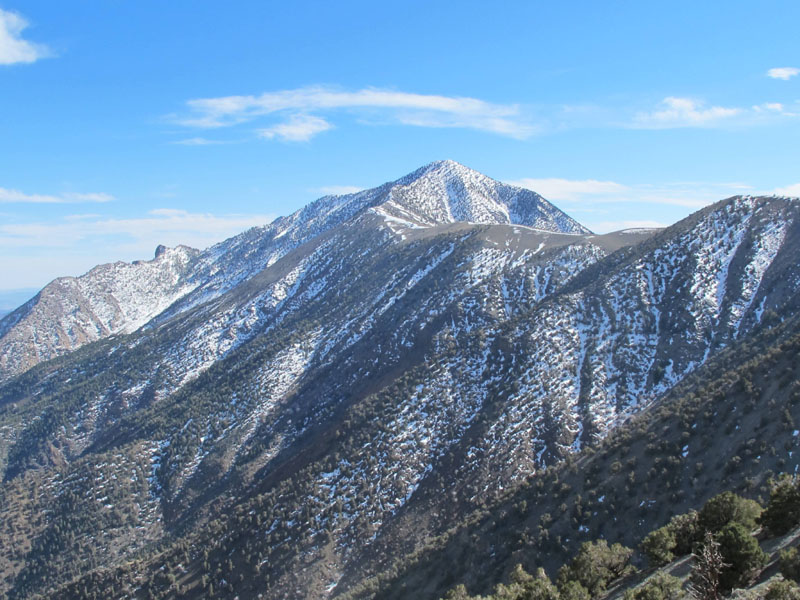 |
Telescope Peak |
Then into the second verse, which opens with a line inspired by a Swahili saying I had collected in my African travels. It still often resonates with me:
"Hyena says, 'I am not lucky, but I am always on the move.'"
Oh, that echoes deep for me, year after year. Like so much African wisdom in the oral tradition, the insight is as chiseled and nuanced as anything by Aesop or Aristotle.
Well, I may not be too lucky, but I'm always on the move
Now I've got nothing to lose, I've got nothing to prove
One thing I have learned - you can't tell yourself how to feel
Surrender to the notion the irrational is no less real
- On the last lonely day
So many things I've buried there
In ghost towns and abandoned mines
So many things I've carried there
That I will leave behind
- On the last lonely day
An observant fan of songs by the Guys at Work will notice that I recycled the "can't tell yourself how to feel" idea into another song on Vapor Trails, "How It Is," and the "lowest low and the highest high" into "Ghost Rider."
Because salvage!
(I actually call my file of leftover lyrical ideas the "Scrapyard.")
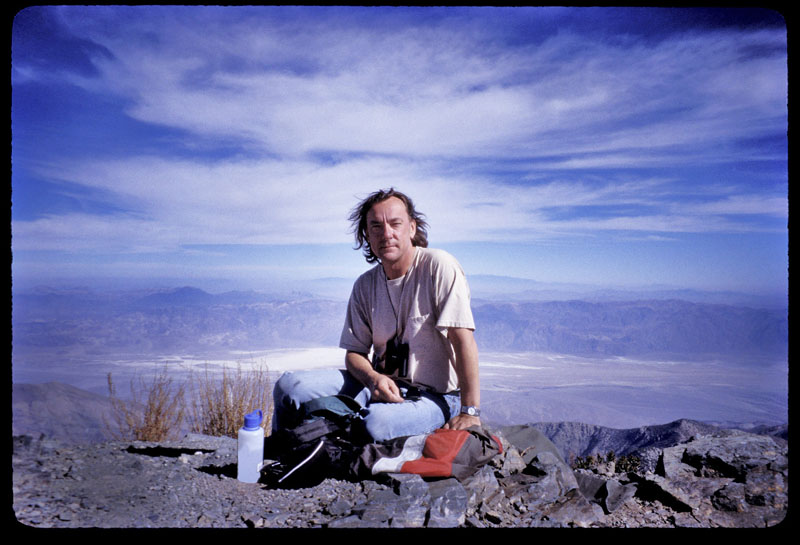 |
Telescope Peak, October, 1999 |
This excerpt from a letter to Brutus in Ghost Rider describes that first ascent, starting with the motorcycle approach.
And that was just to get to the trailhead, at 8,000 feet. Then seven miles on foot up to the summit, through ascending ranges of sage, then juniper, then pinyon pine, mountain mahogany (another tree, like the giant sequoias and ponderosa pines, that needs fire to germinate), limber pine above 9,000 feet, and finally the ancient bristlecone pines, above 10,000 feet.
The summit itself was pretty much bare, jagged rock (though it felt pretty comfortable to lay on by the time I got there), with only a few grasses, but the view, of course, was stupendous. The whole valley so far down, the white floor around Badwater (the part they call the "chemical desert"), and the oasis of Furnace Creek just a tiny green smudge. And far below to the west, Panamint Valley, with its brown furrowed mountains, heaping of sand dunes at one end, the highway across it invisible except to my imagination, and somewhere way over there, Father Crowley Overlook.
Now, though, I'm tired and sore. Coming down was once again nearly as tough as going up - except it was easier to breathe, at least. At one point I was enumerating my pains as I walked: neck, shoulders, back, lower back, hips, thighs, hamstrings, knees, calves, ankles, and, especially, feet. (Waaah!) But I made it without needing a helicopter rescue.
This time, on April 9, 2014, I rode up the graded gravel track to the Wildrose trailhead, beside the Charcoal Kilns (see "December in Death Valley," in Far and Away). The road was dry, but patches of snow remained among the pinyon pines to either side. (Death Valley has a double treeline - the usual upper limit beyond which trees will not grow, and a lower line, defined by heat and dryness, below which no trees live.) Climbing from there, a sign warned that high-clearance four-wheel-drive might be required. The track became narrower, steeper, and badly rutted, with solidified mud and gravel studded with larger rocks. I switched the motorcycle's traction control setting to "Enduro," to allow for some wheelspin, then stood on the pegs and bounced up another mile or so. I parked near the Mahogany Flats campground, at 8,113 feet.
Changing from riding gear into hiking clothes and shouldering my daypack, I stopped at the register for the Telescope Peak trailhead. It was like a raised metal desk with a lid, and inside was a pad of paper and assorted pens and pencils. The most recent entry, dated two days before by "two adults," said "We summited!" I took that as encouragement. Not an omen, but a glimmer of... possibility.
I picked up a pencil and signed in below.
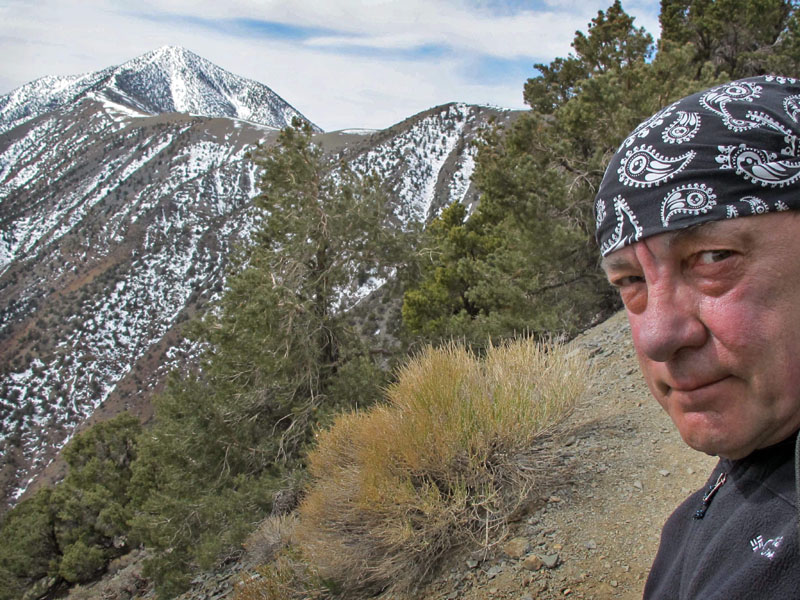 |
Are You Serious? |
4/9/14Bubba9:10
A couple of miles later, maybe a thousand feet higher, I rounded a point among the limber pines and saw the above view of distant Telescope Peak. And all that snow. The expression in my self-portrait echoes the "Are You Serious?" theme used before about cross-country skiing self-portraits, skimming downhill in a blizzard at zero Fahrenheit. This time I mentally added an expletive to that rhetorical question - for extra emphasis.
Because it sure didn't look good.
(Despite all of that precipitation apparent just above Death Valley, the valley floor had received just one third of an inch of rain that year - less than two inches since the previous spring. Whatever moisture got by the barrier of the Sierras to the west, the Panamints intercepted, leaving Death Valley in a double rainshadow.)
Without giving it much thought, I decided to set out and keep going upward as long as possible, then turn around. Hard to quarrel with that plan - except perhaps with the debatable line of what defined "possible." Farther along that difficult trail, I would discuss that line with myself more than once - wondering if perhaps I had reached it.
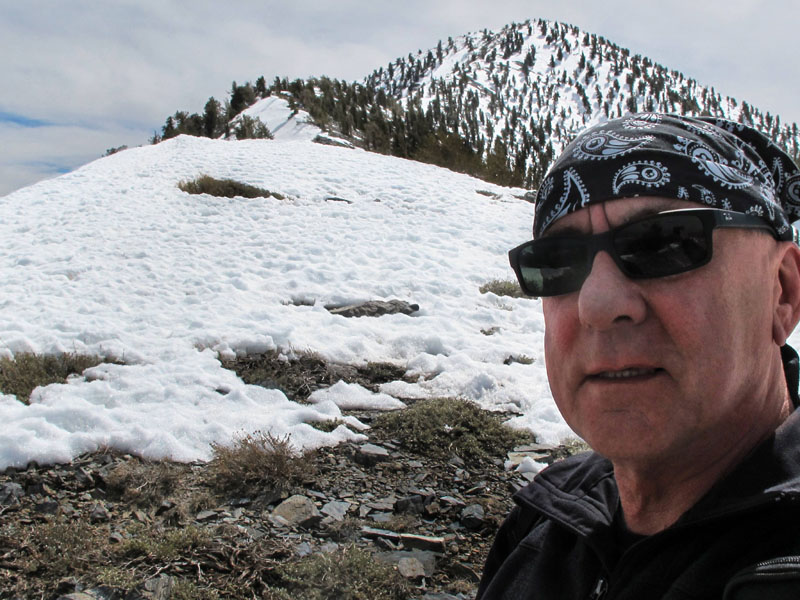
Around this point I looked up and saw three tiny figures coming the other way - animals, I thought at first, but they turned out to be three hikers, young guys. I gave them a wave and a smile, but did not pause in my determined march. Two of them seemed to be together, maybe Europeans, for they wore sports clothes - like soccer or rugby uniforms, and athletic shoes - rather than hiking gear (yes, I'm the fashion police when it comes to backcountry hiking, cross-country skiing, or motorcycling), and carried no packs. Where the snowfield ended (for them - began for me), the third guy moved wide to pass around us, then broke into a trot. He appeared to be a Trail Runner (I'm sure he capitalized and adopted the name in his social media). Below his man-bun and poetic facial hair, he was dressed collar to cuffs in tight lycra, with a yoke-like affair over his shoulders carrying bottles of water. He was wearing those funny little shoes with the separate toes (I noticed from his tracks in the deep snow after that - must have been cold).
Later, following their tracks upward, smiling darkly at the toe-shaped ones, I saw where Trail Runner had fallen. The thin, waffle-patterned sole and toes had slipped down the icy surface a fair distance, ending where his curled-up body shape was pressed into the white slope, shoulders and knees facing downhill. Snow can be treacherous - dangerous.
Apparently there is some debate about how many words the Inuit actually have for frozen water, but as a Native Canadian, I can attest that snow has many, many different manifestations upon the Earth. Powdery soft to rock-hard, blinding white to shadowy blue, fairytale woods to gray city slush.
A few stories ago, I was grappling with some large, slippery concept - something do to with the way people's impressions of an alien landscape, like, say, "the desert," or "the mountains," was always simplistic and reductive. I introduced the existential notion that "Nothing is ever just one thing."
Later I was surprised to see the great New York Times columnist Maureen Dowd use that exact phrase, and I wondered, "Hey - where'd she get that?" Then I learned that a master writer got there before either of us: Virginia Woolf, in To the Lighthouse, "For nothing was simply one thing."
Well, yeah. Because complicated.
Long digression short, to say that nothing is simply one thing is abundantly true of snow.
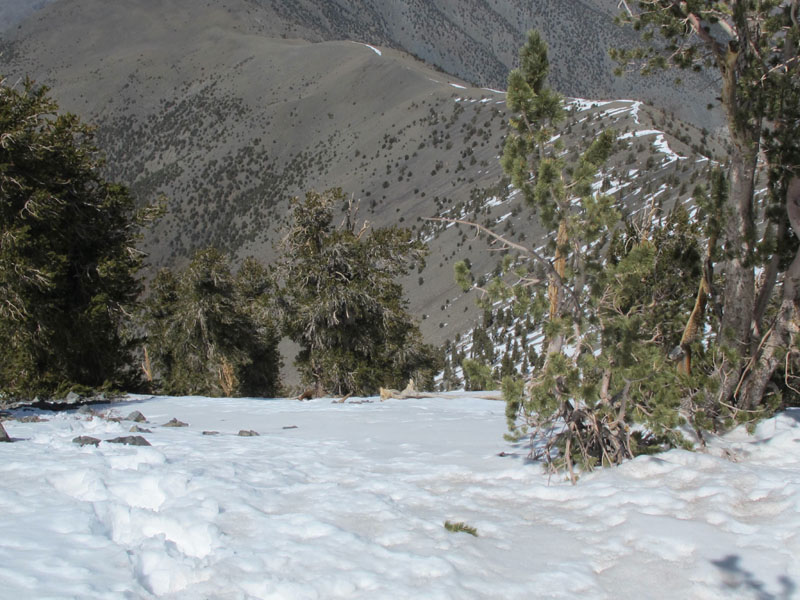
Where the trail followed the ridges and saddles (one with the great name of Arcane Meadows - "secret, mysterious, known to only a few"), I could either sidestep the drifts - some up to two feet deep - or labor through them, as I saw previous hikers had done. However, that surface was not reliable; sometimes I could make a few steps on top of the drift, then suddenly one boot would sink deep, tripping me up and needing extra effort to get out and move on. Breathing was difficult in the thin air, so every lungful was guarded and precious. (Somewhere I learned only to think about the exhale, because you're going to breathe in naturally anyway, and that always works for me.)
Another hazard was that after a few such deep plunges, the loose snow gathered around my boottops and wicked down into my socks, until they were soaked through. Now I worried about blisters - I still had a long way to walk, even if I turned around before the top.
On steeper pitches, as shown above, I could kick my toes into the softer snow and lever upwards. But occasionally the snow wasn't soft, but icy and unyielding, and that wasn't nice to kick. Sometimes I could "herringbone" my boots, edged in and splayed outward, as in cross-country skiing. But with either technique, too many times the snow gave way under my weight, and I would slide back down a step, and that was discouraging. I would have to work harder to regain my balance, often crying out in surprise and frustration, and would lose that precious step upward. Falling was a worse fear, especially around exposed rocks - they were often sharp-edged blocks of gneiss, which could cause a serious injury, especially to a vulnerable knee. Even falling into the yielding snow was tough, because of the effort of struggling up again. I paused often to catch my breath (I mean look at the view!), and altogether it was becoming a challenge on the edge of my determination.
Have I reached that line yet?
Looking upward, the steep snowfield between jagged rocks and weathered trees seemed to rise so high above me. And I couldn't know if that visible edge actually represented the summit, or if I would arrive there to find another arduous slope of rock and snow. Body straining, my mind grew dim, and fanciful. Maybe I should turn around - hell, I could even claim to have made it, no one would know. Those three guys probably hadn't made it all the way up (I hadn't asked, not wanting to be discouraged). Perhaps two days ago, when the two hikers wrote "We summited!" in the trail register, they had lied. Or maybe that day the snow had been easier, firmer underfoot on those steeper pitches. All I knew was, this was getting to be... too much.
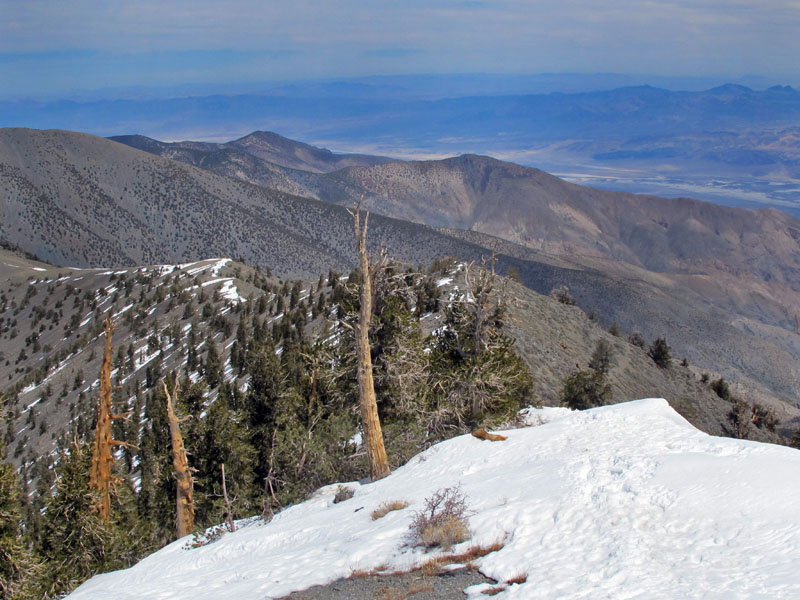
But I kept climbing, one foot in front of the other, for a long time. (I am very bad at giving up - must work on that.) By then, the hours had become an arc of effort - it felt like I had started the hike straining for the first couple of miles, then settled into a steady groove for a while, but now - surely toward the end - it was punishingly hard again. That reminded me of other such ordeals, like what bicyclists call a "Century," where you ride a hundred miles in one day. In the '80s and '90s I had done a number of Centuries, and always found that the first ten or twenty miles seemed hard, and it was impossible to contemplate the entire distance from that tender beginning. Then a groove would take over for sixty or seventy miles - the endorphins and dopamine, I guess - erasing time and distance. Those miles fell behind easily. Then, as if in withdrawal from those sustaining drugs, the last ten miles crashed down on me. Weariness and discouragement turned those final miles into a dark slog.
Sometimes cyclists choose to do a "Metric Century" instead, meaning a hundred kilometers, or sixty-two-point-five miles. I smiled to think that I was almost a metric century, at sixty-one-point-five years, so no wonder this climb felt so tough. The last time I had done it was fifteen years ago, after all, when I was a mere forty-six - a child!
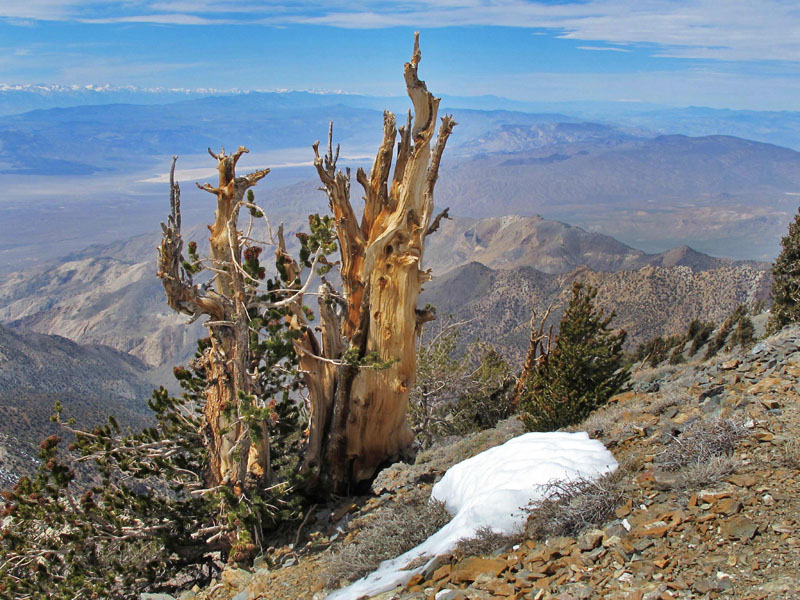 |
Bristlecone Pine |
Compared to the ancient bristlecone pines that clung to the highest elevations around me, we were all children. Unborn cells, really. Apart from creosote colonies, bristlecones are the oldest individual organisms on Earth - as much as 5,000 years, dating to the time of the pharaohs. The example pictured above, with the Panamint Valley and the white line of the snow-crested Sierra Nevada behind, is actually still alive, despite being cruelly blasted by millennia of harsh weather and lightning.
Finally, finally, finally, I crested the peak. It was a "false summit," but I remembered that a short saddle led to the actual top. (I didn't see any recent tracks in the snow there, so wondered if the three young sportsmen had turned around a little too soon.) The actual summit was a roughly circular pedestal of barren, square-faulted rock, with only a few hardy grasses in the cracks. An old metal ammunition box rested at an angle, and you could leave a note if you wanted. I didn't.
Because tired.
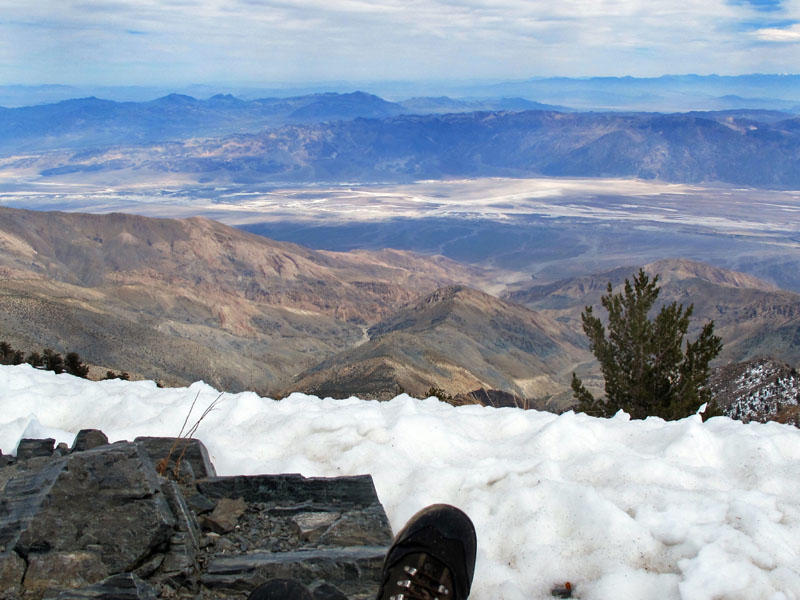 |
BootCam™ |
Telescope Peak was climbed and named in 1861 by Dr. Samuel George. He said he could see so far that it reminded him of looking through a telescope. Nicely played, Doc.
I eased myself down onto those sharp-edged rocks, and stretched my legs out toward a lingering snowdrift, facing down over Death Valley. One slab of rock offered a decent angle, and I leaned back against it, feeling nothing but relief. (Though always with an undercurrent of anxiety, still facing the long, perilous descent.) Taking my time, I looked around at the 360-degree view, drank some water, ate an apple, a stick of cheese, and a chocolate wafer bar.
My feelings were certainly "elevated," though hardly ecstatic - I knew I still had a long hard walk back to my motorcycle. But I had made it to that summit. Even at the ripe old age of a Metric Century. And that did feel good.
The ammunition box came in handy as a camera stand, for a self-timer shot of my summit triumph.
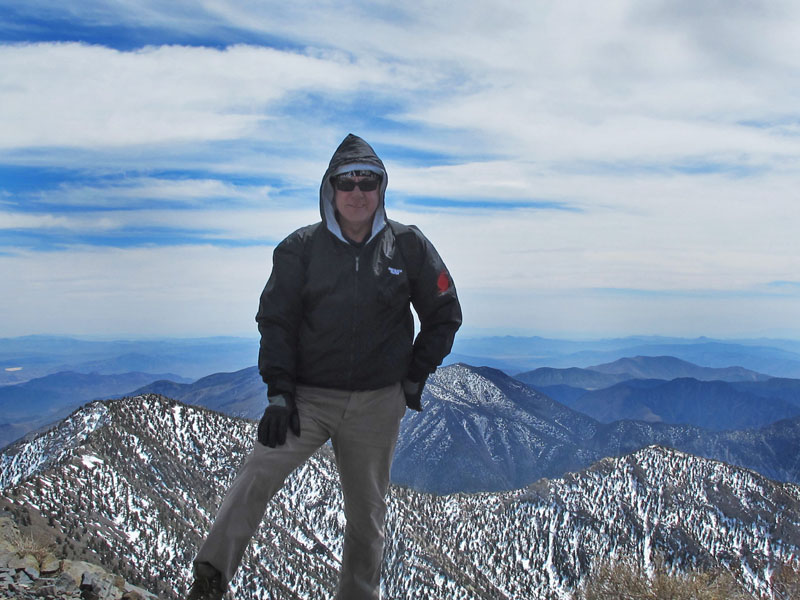 |
"Don't Ever Do This Again!" |
Taking up my pack again and heading down, the steep, snowy pitch was nearly as hard to descend as it had been to climb, and just as dangerous. Mostly I followed my previous trail, now kicking my heels into the snow, and traversing across the steepest patches. Sometimes I held onto a rock, or grabbed at a limber pine branch (great smell they have, as do the high-elevation sages), feeling my legs aching and occasionally quivering with the strain. I plodded, slogged, and marched across the saddles, the wind driving in from the west in powerful gusts that pushed me sideways. (People on mountain ledges get killed that way, too - blown off by unexpected winds. Good thing I was "well-weighted.")
Mostly my eyes were down on the trail, watching my footing (that's why bandanas are my preferred hiking headgear, to absorb sweat while allowing me to see ahead), but occasionally I paused and stood looking around at the view - west to Panamint Valley and the distant Sierras, east over the pale expanse of Death Valley, the dark Funeral Mountains, and the faroff, snow-tipped White Mountains in Nevada.
My thoughts churned away, but at nothing in particular. I have always found that when I am exerting maximum will, my thinking is not imaginative. (Somewhere Isak Dinesen wrote about the reverse conclusion: "... the freedom of the artist, who has no will, who is free of will." That explains a lot about tragic artists, that's for sure.) Exercising in a gym, riding a bicycle or motorcycle, or hiking in the mountains has never produced a creative thought for me (drumming is the only activity in my life that combines athletic activity with creative thinking - and that's plenty). Typically, during an ordeal like that hike, the best my mind can do is work at "writing exercises" - trying to observe and put what I see and feel into sentences, then remember it for when I try to write it, to share it.
Dark imaginings of falling and hurting myself badly, or being struck down by some cardiovascular "event," made me think of hypothermia - as in "dying of." That reminded me of a word I had just learned, "hyperthymia." It is basically defined this way: "Hyperthymic people have so much energy, do so many things, and get so much done that it annoys other people."
Oh dear. Some who know me well will laugh at that - others will be annoyed. Because truth.
In fact, ahem, well, if I do say - it's so true that I even often annoy myself. Like on that hike, there was a moment when I thought of something simple and important enough that I paused to write it down, "Don't ever do this again."
Later I added a joke, "No more suffering on purpose, okay?"
Brother Danny offered a suitable quote (as always) from British mountaineer C. F. Meade:
"Whatever agonies and miseries the sufferer may endure on his pilgrimage to the heights, and however often he may swear never to return there, longing to do so is certain to recur."
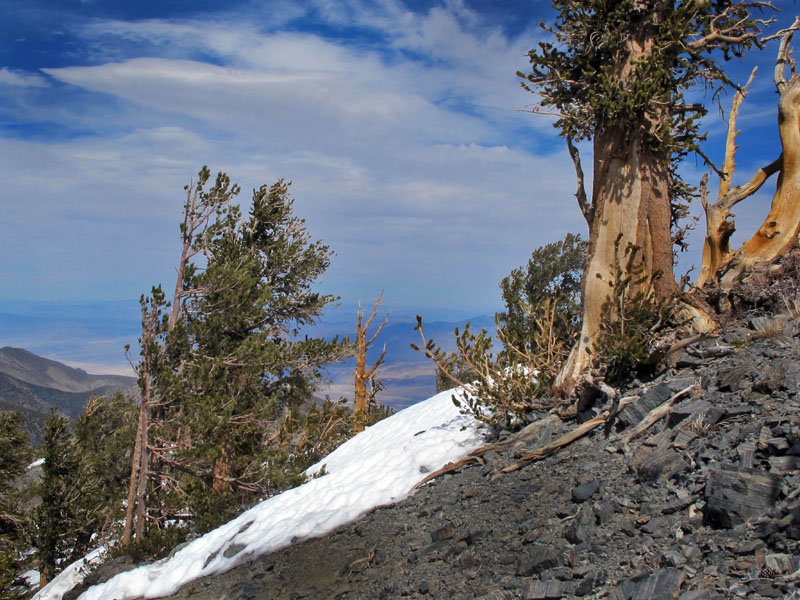 |
The Way the Wind Blows |
The previous week I spent an afternoon at Drum Channel, borrowing a little drumset in the studio for some casual "explorations." It was gratifying to learn that my technique remained "ingrained" (I said to Don Lombardi, "The machine still works!"), and that having stepped away from the routine of it allowed me to think in surprisingly fresh ways. It was an enjoyable, rewarding few hours - but after, I thought about doing that every day, like rehearsing for a tour. The idea did not appeal. The same with the 950-mile motorcycle ride to Death Valley and back, and all the packing and unpacking - it did not make me want to go back to doing that every day, like on tour.
But that decision is far in the future - we'll see which way the wind blows then. Perhaps, as the man said, "longing to do so is certain to recur."
On that endless march down from Telescope Peak, every time my eyes followed the trail curving far around a ridge ahead, I hoped it would be the last one. But those long ridges went on and on, until I wondered if I had somehow got on the wrong trail. There was only one trail up there - it had just grown longer since I climbed it a few hours before. My body was a tired, aching slave, and my mind was a dark, empty engine of will. I kept going because there was nothing else to do.
(One helpful consolation of old journals and writings is that they can help correct some illusions of memory. Like the common refrain that something hard was ever easy - the truth is that you just forget over time! Recall my list of aches from the '99 hike: "neck, shoulders, back, lower back, hips, thighs, hamstrings, knees, calves, ankles, and, especially, feet." Nothing different fifteen years later!)
At last I reached the trailhead, and stopped to sign out in the register. (I noticed the three sportsmen had been too cool for that precaution - or courtesy, you might say. To save others worry and trouble.)
4/9/14Bubba9:10
4:45
Tough going, fair bit of snow.
But got 'er done.
That's the way Bubba would say it.
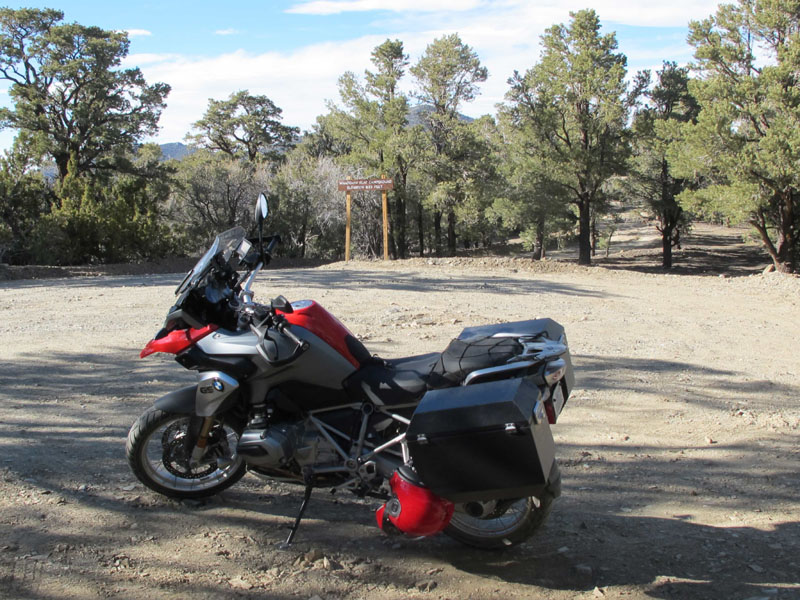
My motorcycle waited alone in the parking lot, I was glad to see, with the shadows growing long. Earlier, when I was setting out, a late-model SUV had been parked there, its sides dusty and badly scraped by branches (probably a rental, to be abused so recklessly!), and one campsite had been occupied with a tent and four-wheeler. That may have accounted for the three hikers I encountered, coming down so early, but the place was deserted now. The nearest people were at the Wildrose Campground far below, so if anything nasty had happened, it would have been at least a day before someone noticed my abandoned motorcycle and finally came looking for me. Almost certainly too late, in that extreme exposure.
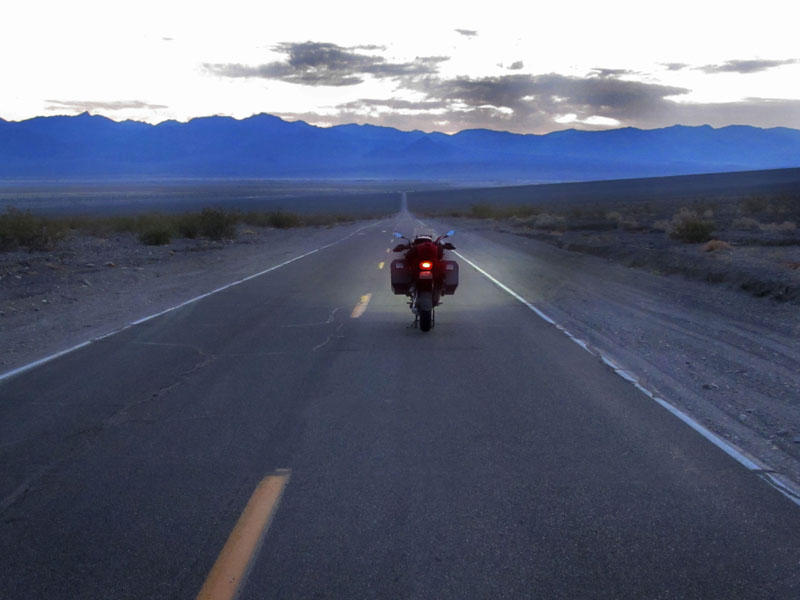 |
Death Valley Sunrise |
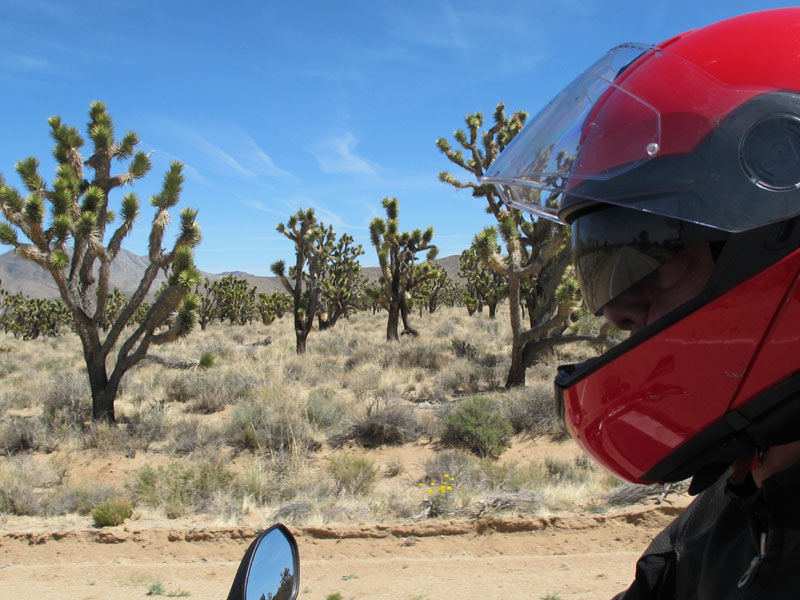 |
Bonus Picture |
I struggled out of my hiking boots and back into my riding gear, the effort of bending over and getting boots on and off enough to set me groaning and grumbling. Swinging a leg over the saddle (ouch!), and standing on the pegs for the first rough descent was also a strain for my weary legs. I was glad to get back to pavement, settle back and just cruise the rest of the way to Stovepipe Wells.
I was thinking along predictable lines. There will be whisky. There will be a hot shower. There will be steak. There will be red wine. There will be sleep - early and long.
So let it be written; so let it be done.
Before sunrise I was up and quietly packing the bike, aiming to ride out through the other "classic" point of entry, Townes Pass. So many stories attach themselves like flags to places all over Death Valley for me - even that pass. One shining memory is riding in that way for the first time, in autumn, 1996, with Brutus - earlier pausing at Father Crowley Overlook above Panamint Valley as the moon rose, then over Townes Pass and into Death Valley, seeing the place for the first time like that.
Another story tells of a Chicago businessman named Albert Johnson who visited early in the 20th century, and found relief for his health in the arid heat. In the 1920s, he and his wife Bessie constructed a massive Mission-style mansion in Grapevine Canyon. He employed a character named Death Valley Scotty to look after the place (it soon came to be known locally as Scotty's Castle, which suggests a tale or two), and the story spins out from there. In 1943, Albert Johnson's wife Bessie was killed in a car accident in Townes Pass.
My entire journey to Death Valley this time had become a pilgrimage of sorts, not only to Telescope Peak, but to the place itself. Even choosing to ride in through Death Valley Junction to Dante's View, rather than the equally scenic Salsberry Pass route out of Shoshone and past Badwater, had been deliberate - to make this visit emblematic. Not just memorable, but a summary of all of my memories of the place, and a symbol of what I hoped I could share with others.
Because magic.